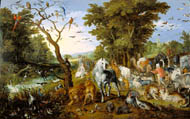This activity prepares students for the Guided Lesson at the Getty Center, Nature in Art. Students consider how an artists interprets nature. They look at a poster of Brueghel's painting of Noah's Ark, with many natural elements, and share their personal ideas about what they see. |
 |
 |
Overview: Explain to your students that their gallery lesson in the Museum at the Getty Center will be Nature in Art.
This activity will help them start thinking about how artists can create works of art inspired by nature.
During the lesson, it will be important for them to slow down, look closely, and describe what they see.
Step 1: Ask your students to define the word nature. Make a list of their responses.
Step 2: Display the poster of Jan Brueghel the Elder's The Entry of the Animals into Noah's Ark,
painted in 1613. Don't tell your students the title of the painting until the end of the activity. Ask
the students, working in small groups, to make a list of the things in the picture they see as part of nature;
have them use an "adjective-adjective-noun" format (e.g., prancing white horse).
Step 3: After students list as much as they can see, ask them to share their observations. Some students will have
seen things others did not, and some will use different adjectives to describe the same natural elements.
Step 4: Talk about the artist's method.
Ask students what about the animals makes them look real? Tell your students that an artist created this painting
about 400 years ago. At this time, photography had not yet been invented. Jan Brueghel, the artist, had to closely
observe animals and their behavior so that he could make them look real. The artist worked for a powerful ruler who
had a menagerie (similar to a zoo) so that he could regularly see and visit a large collection of exotic animals.
With the discovery of the New World in the 1600s came an increased curiosity about natural history. This interest
led many European rulers, who had in the past collected stuffed animals, shells, and other natural objects, to form
menageries of rare live animals.
Step 5: Talk about the story.
Did anyone notice that most of the animals are in pairs? Did anyone see an ark or a boat?
(Hint: it's tiny—look above the monkey's head on the bare tree to the left of the center.)
Talk about how the artist was inspired by the biblical story of Noah's Ark (for background information,
see description of the artist and the painting by clicking on image above). Talk about how and what the
artist emphasized (the animals are featured prominently in the foreground while the people and boat are
small and placed in the background). The artist wanted to celebrate and convey the variety and beauty of creatures in nature.
*Extension for grades K–5
Have the students create a poem about the picture in the form of the story "Brown Bear, Brown Bear, What Do You See?"
*Extension for grades 6–10
Give students a list, or have them look at the list, of endangered and threatened species at the U.S Fish and Wildlife
Service Web site. Ask students to select one animal from the list.
Have them write a one-page paper or prepare a short presentation about the animal. Have them consider the following questions:
• What is the animal?
• Where can it be found?
• Why is it threatened?
• What is—or is not—being done?
• Should the animal be preserved? Why or why not?
• What would it mean to preserve the animal? For example, if the animal only existed in zoos, would that constitute it being saved?
• Are we responsible for preserving nature? Why or why not? |
 |
 |
 |
| The Entry of Animals into Noah's Ark, Jan Brueghel the Elder, 1613 |
 |
|
The following content standards will be covered in your Guided Lesson at the Getty Center.
Visual Arts Content Standards for California Public Schools
Artistic Perception
1.0 Processing, Analyzing, and Responding to Sensory Information through the Language and Skills Unique to the Visual Arts
Students perceive and respond to works of art, objects in nature, events, and the environment. They also use the vocabulary of the visual arts to express their observations.
Historical and Cultural Context
3.0 Understanding the Historical Contributions and Cultural Dimensions to the Visuals Arts
Students analyze the role and development of the visuals arts in past and present cultures throughout the world, noting human diversity as it relates to the visual arts and artists.
Aesthetic Valuing
4.0 Responding to, Analyzing, and Making Judgments about Works in the Visual Arts
Students analyze, assess, and derive meaning from works of art, including their own, according to the elements of art, the principles of design, and aesthetic qualities.
|
 |

|

